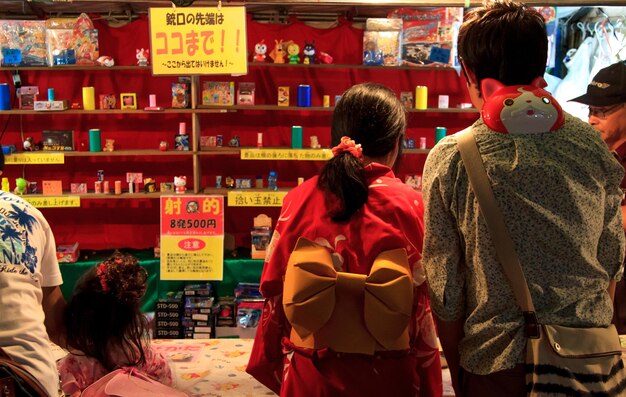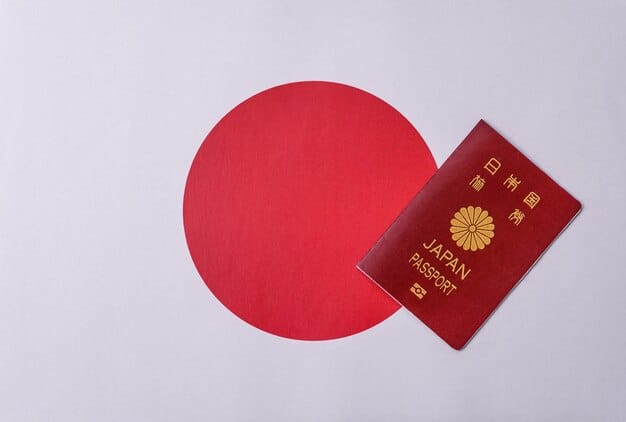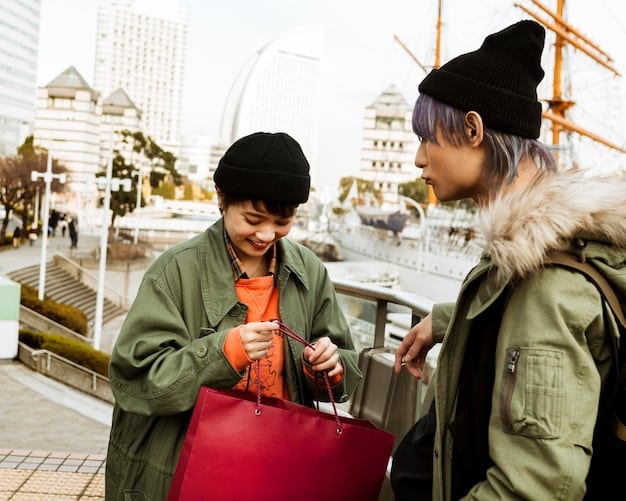Duty-Free Shopping in Japan: US Citizen’s Saving Guide

Duty-free shopping in Japan allows US citizens to save 8% on purchases by understanding eligibility, required documents, and navigating the process at various locations like airports and department stores, ensuring a seamless tax-free experience.
Navigating the vibrant shopping scene in Japan can be even more exciting when you realize you can save money through duty-free shopping. This duty-free shopping in Japan: a step-by-step guide for US citizens to save 8% on purchases will walk you through everything you need to know to take advantage of this perk.
Understanding Duty-Free Shopping in Japan
Duty-free shopping is an appealing option for tourists visiting Japan, especially for US citizens. It allows you to purchase goods without the consumption tax, which is currently 8%. Taking advantage of this system can lead to significant savings, especially on higher-priced items.
Who is Eligible for Duty-Free Shopping?
To be eligible for duty-free shopping in Japan, you must be a non-resident. This generally means that you are staying in Japan for less than six months. Specifically, US citizens visiting Japan for tourism or business purposes are eligible.
Required Documents for Duty-Free Shopping
To claim your tax exemption, you’ll need a few essential documents. It’s crucial to have these ready when making purchases.
- Passport: Your original passport is essential. A copy will not suffice.
- Entry Stamp/Immigration Record: An entry stamp or immigration record proving your tourist status is required.
- Purchase Record: The store will usually provide this, but always double-check you receive it.

Knowing these prerequisites ensures a smoother shopping experience. Keep your documents together and readily accessible whenever you shop.
Where to Find Duty-Free Shopping Locations
Duty-free shopping isn’t limited to just airports. Many retailers throughout Japan offer tax exemptions to eligible tourists. You can find duty-free shops at various locations, enhancing your shopping convenience.
Airports
Airports are classic spots for duty-free shopping. Before departing from Japan, you can purchase items at discounted rates in the airport’s duty-free shops. These are generally located after you pass through security.
Department Stores
Many major department stores throughout Japan also offer duty-free services. These stores often have dedicated counters where you can process your tax refund after making your purchases.
Specialty Shops and Boutiques
Increasingly, smaller specialty shops and boutiques are also offering duty-free shopping. Look for a “Tax-Free Shopping” sign displayed in the store window or near the cash register.
When in doubt, don’t hesitate to ask a store employee if they offer tax-free shopping. They can guide you through the process and answer any questions you may have.
Step-by-Step Guide to Duty-Free Shopping
The process for claiming tax exemptions is fairly straightforward. By following these steps, US citizens can easily save 8% on their purchases in Japan.
Step 1: Make Your Purchase
Shop for the items you desire at a store that offers duty-free services. Remember that some stores may have a minimum purchase amount to qualify for the tax exemption, often around 5,000 yen.
Step 2: Present Your Documents
At the checkout, present your passport and entry stamp to the cashier. They’ll verify your eligibility and process the tax exemption. Make sure all details are accurate.
Step 3: Sign the Purchase Record
You’ll be asked to sign a purchase record provided by the store. This document confirms that you are taking the purchased items out of Japan. Keep this receipt with your passport to present upon departure if required.
Step 4: Securely Pack Your Items
In some cases, items purchased duty-free may need to be sealed in a special bag. Do not open this bag until you have left Japan. The cashier will advise you if this is necessary for your purchases.

By following these steps attentively, you can ensure a seamless duty-free shopping experience in Japan.
Tips for a Smooth Duty-Free Experience
While duty-free shopping is generally easy, a few tips can make the process even smoother, ensuring compliance and satisfaction.
Be Aware of Minimum Purchase Amounts
Many stores have a minimum purchase amount to qualify for duty-free shopping, typically around 5,000 yen (approximately $35-$40 USD, depending on the exchange rate). Check the store’s policy before you start shopping.
Keep Your Receipts Organized
Keep all your purchase records, receipts, and passport together in a safe place. You might need to present them when leaving Japan.
Don’t Open Sealed Bags
If your purchases are sealed in a special duty-free bag, do not open it until you have left Japan. Opening the bag might render you liable for the consumption tax.
Plan Your Purchases
To make the most of your tax exemption, plan your purchases in advance. Knowing what you want to buy and where to buy it can save time and ensure you meet the minimum purchase requirements.
With these tips in mind, you’ll enhance your duty-free shopping experience, maximizing both convenience and savings.
Common Mistakes to Avoid
Avoiding common pitfalls can save you time and prevent potential issues during your duty-free shopping spree. Awareness is your best defense.
Forgetting Your Passport
This is the most common mistake. Always carry your original passport when shopping. No passport, no tax exemption.
Opening Sealed Bags Prematurely
Opening sealed duty-free bags before leaving Japan is a surefire way to forfeit your tax exemption and potentially face additional charges.
Exceeding the Spending Limit
Be mindful of the total amount you’re spending. While there usually isn’t a strict upper limit, unusually large purchases may raise questions from customs officials.
Buying for Others
Duty-free purchases are intended for personal use. Buying items for others can be problematic if discovered.
Staying proactive and informed about these common mistakes helps guarantee a hassle-free and rewarding tax-free shopping experience in Japan.
Navigating Customs with Duty-Free Items
Understanding what to expect as you depart from Japan with your duty-free purchases will help ensure a smooth transition through customs.
Be Prepared to Present Documents
Have your passport, purchase records, and any other related documents readily available. Although it is rare, customs officials may ask to inspect your purchases.
Declare High-Value Items
If you’ve purchased high-value items, be prepared to declare them as you enter back into the US. There are limits to how much you can bring back without paying US duties, so research the current regulations.
Keep Items Accessible
Keep your duty-free items accessible in your carry-on luggage. This allows customs officials to easily inspect them if needed.
By being well-prepared and informed, you can confidently navigate customs and enjoy the savings from your duty-free shopping in Japan.
| Key Point | Brief Description |
|---|---|
| 🛂 Eligibility | Non-residents staying less than six months qualify. |
| 🛍️ Locations | Airports, department stores, and specialty shops offer duty-free. |
| 📝 Documents | Passport and entry stamp are required for tax exemption. |
| 袋 Sealing | Keep duty-free bags sealed until you exit Japan. |
Frequently Asked Questions
▼
Duty-free means you’re exempt from paying consumption tax (8%) on your purchases at the time of sale. This is available to eligible tourists who meet certain requirements, making shopping a bit cheaper.
▼
Yes, most stores require a minimum purchase amount, often around 5,000 yen (about $35-$40 USD). This is a combined total, so keep receipts if you plan to use the same store.
▼
Opening the sealed bag before leaving Japan could mean you’re required to pay the consumption tax. Avoid this by waiting until you’re outside Japan to open the package.
▼
No, you must present your original passport to qualify for duty-free shopping. A photocopy or digital version won’t be accepted by retailers offering tax exemptions.
▼
Some items may not qualify depending on the store’s policies. Consumables which will be used in Japan, such as foods and cosmetics, will not be tax free.
Conclusion
Duty-free shopping in Japan offers US citizens a fantastic opportunity to save money while enjoying the country’s rich retail landscape. By understanding the rules, preparing the necessary documents, and avoiding common mistakes, you can enhance your shopping experience and make the most of your visit. Happy shopping!





